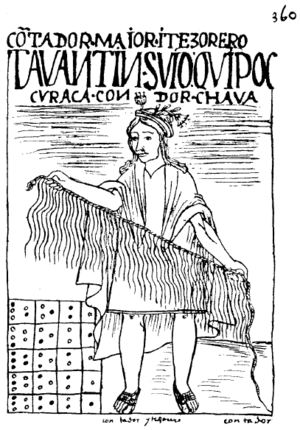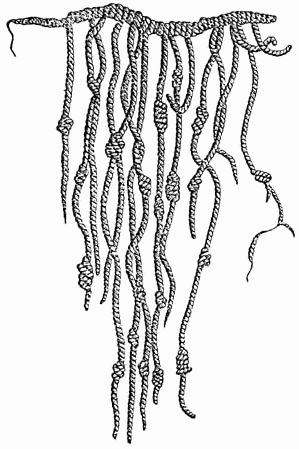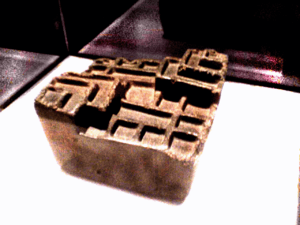Mathematics of the Incas facts for kids
The mathematics of the Incas was a special kind of math used by the Incas before the Spanish arrived. It was very practical and helped them manage their large empire. The Incas used tools like the quipu and the yupana to keep track of numbers.
They had a simple but effective way of counting, based on the decimal system (like we use today). They even knew about the number zero! The Incas were good at adding, subtracting, multiplying, and dividing. Their math was mostly for managing things, keeping records, and measuring, not for complex theories like some other ancient cultures.
The Incas also needed math for building amazing things. They constructed long roads, irrigation canals, and huge stone buildings. This required a good understanding of geometry, which helped them measure distances, areas, and design their cities and forts. They also had their own ways to measure length and volume, often using parts of the human body as a guide.
Contents
How Incas Counted: The Decimal System
The Incas mainly used a base-ten number system, just like us! We know this from old stories and records. These records show that the Inca government organized people using groups of ten. For example, there were leaders in charge of 10 families, 100 families, and even 1,000 families.
The quipus, which were knotted strings, also show this. The knots on a quipu were arranged to represent units, tens, hundreds, and so on. This is very similar to how we write numbers today.
Even the names of numbers in Quechua, the Inca language, prove they used a decimal system. Look at this table to see how they named numbers:
| Number | Quechua | Number | Quechua | Number | Quechua |
|---|---|---|---|---|---|
| 1 | Huk | 11 | Chunka hukniyuq | 30 | Kimsa chunka |
| 2 | Iskay | 12 | Chunka iskayniyuq | 40 | Tawa chunka |
| 3 | Kimsa | 13 | Chunka kimsayuq | 50 | Pisqa chunka |
| 4 | Tawa | 14 | Chunka tawayuq | 60 | Suqta chunka |
| 5 | Pisqa | 15 | Chunka pisqayuq | 70 | Qanchis chunka |
| 6 | Suqta | 16 | Chunka suqtayuq | 80 | Pusaq chunka |
| 7 | Qanchis | 17 | Chunka qanchisniyuq | 90 | Isqun chunka |
| 8 | Pusaq | 18 | Chunka pusaqniyuq | 100 | Pachak |
| 9 | Isqun | 19 | Chunka isqunniyuq | 1000 | Waranqa |
| 10 | Chunka | 20
Iskay chunka |
1 000 000 | Hunu |
Inca Accounting Tools
Quipus: Knotted Records

The quipus were a system of knotted strings that helped the Incas remember and record all sorts of information. They were used for math, like keeping accounts, and also for tracking things like how many people lived in an area, how much food was stored, and how many products were made. Some people even believe quipus were used to record history!
Special people called quipucamayoc (kee-poo-kah-MY-oc) were experts at reading and making quipus. They were very trusted and managed the records for whole regions. Even today, in some villages, quipus are still used to keep track of crops and animals.
Yupanas: Inca Calculators
Before recording numbers on quipus, the Incas did their calculations on tools called yupanas. These were like abacuses. Yupanas could be made from carved stone or clay. They had different sections or compartments that stood for units, tens, hundreds, and so on. People would use small stones or grains of corn to count on them.
Recent studies suggest that yupanas might have used a number system based on 40, not just 10. If this is true, it's a very interesting discovery! In 2010, a Peruvian researcher named Andrés Chirinos figured out how the yupana worked. He called it a "pre-Hispanic calculator" because it could add, subtract, multiply, and divide. This discovery gives hope that we might one day fully understand how quipus worked too!
Inca Measurement Systems
The Incas had different ways to measure things like length and how much space something took up. Like many ancient cultures, they often used parts of the human body as their measuring tools. There wasn't just one standard system for everyone; different areas might have had their own ways of measuring.
Measuring Length
For length, the Incas used:
- The rikra (REE-krah): This was the distance from one thumb to the other when a person stretched their arms out wide. It's similar to a fathom.
- The kukuchu tupu (koo-KOO-choo TOO-poo): This was the distance from the elbow to the end of the fingers, like a cubit.
- The capa (KAH-pah): This was the length of a span, from the tip of the thumb to the tip of the little finger when the hand is stretched out.
- The yuku (YOO-koo): This was the smallest unit, the distance between the index finger and the thumb when stretched apart.
For longer distances, like between two villages, they might have estimated it by how many chasquis (runners) it would take to carry a message.
Measuring Surface Area
The main unit for measuring surface area was the tupu (TOO-poo). A tupu was generally the amount of land needed to feed a married couple without children. It wasn't an exact size because it changed depending on how good the soil was and where the land was located. After a few years of farming, the land might need to rest. Then, the couple could ask their local leader for a new tupu.
Measuring Capacity
For measuring how much a container could hold, the Incas used:
- The pokcha (POK-chah): This was a large unit, about 27.7 liters.
- They measured crops like corn in special containers. Liquids were measured in different kinds of pitchers and jars.
- Coca leaves were measured in large baskets called runcu (ROON-koo). Other baskets were called ysanga (ee-SAHN-gah).
- The poctoy (POK-toy) or purash (POO-rahsh) was the amount of grain or flour that could fit in your cupped hands.
The Incas also had scales with pans and nets, and an instrument called a huipe (WEE-peh), which was like a steelyard. These were likely used by jewelers and metalworkers to weigh precious metals accurately.
Measuring Volume
The Incas measured the volume of their storage buildings, like colcas (storehouses for food) and tambos (state warehouses along the roads). They used portable containers like runqu (bales) or ishanka (baskets). They also understood how the volume of a box-like shape changed if you made it taller but kept the bottom the same size.
Measuring Time
To measure time, the Incas used the day (a workday), which could include a morning or an afternoon. Time was also used to estimate distances. For example, they might say a journey from Cajamarca to Cusco took "20 days."
They also kept track of months, years, and the different phases of the moon. The moon's phases were very important for farming activities like planting and harvesting, and also for navigation.
See also
 In Spanish: Matemática incaica para niños
In Spanish: Matemática incaica para niños




